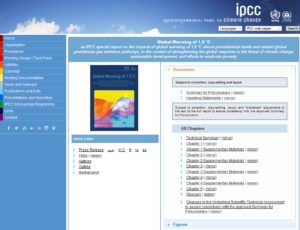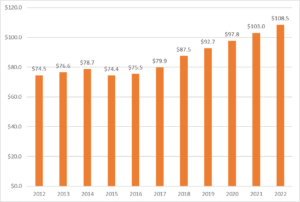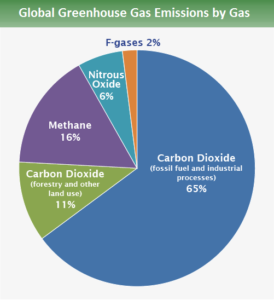Behind the IPCC Curtain: the Costs of Climate Mitigation Policy
By Mark Krebs -- October 18, 2018“Financing the IPCC’s conclusions via carbon taxes would bankrupt even the wealthiest countries; even at the low end of the IPCC estimates…. Alas, we have to destroy the global economy to save it.”
The 48th session of the United Nation’s Intergovernmental Panel on Climate Change convened from 1-5 October 2018, in Incheon, Republic of Korea. On Oct. 6, 2018 the UN’s IPCC modified downward the Paris Agreement goal of a maximum 1.5 deg. C rise requiring net-zero carbon emissions by 2050. The following day, the IPCC released its voluminous “special report” shown by the following screenshot:
Source: http://www.ipcc.ch/report/sr15/
The report went to great lengths estimating the environmental costs of climate change and the benefits (including economic benefits) from implementing their “findings,” but never analyzed the economic costs. In fact, Chapter 1 of the IPCC special report said this about economic cost/benefit analyses (p. 10):
Any comparison between 1.5oC and higher levels of warming implies risk assessments and value judgements, and cannot straightforwardly be reduced to a cost-benefit analysis (Kolstad et al., 2014).
Regardless, the report did go on to put a price range on what it would take in the form of carbon taxes to avoid what the IPCC claims will be “Catastrophic Anthropogenic Global Warming.” Yet the IPCC never quite defines that nor what the global damages would be in such a scenario.
Without that, there’s no reason to conclude ‘just any cost’ would be worth it to avoid such. As indicated below, the cost themselves would be ‘catastrophic’ and lead to chaos and likely the end of the current world order. The carbon tax is but one, albeit significant, part of what it would take to result in net zero carbon emissions.
That range of taxes is between $135 and $5,500 per (metric) “tonne.” Importantly, if the world is going to buy insurance against “Catastrophic Anthropogenic Global Warming” the least we could do is insure reasonable premiums. As Robert Murphey pointed out in 2014 (here):
Climate change mitigation policies are now routinely described as a form of “insurance,” which admittedly may end up costing more than they’re worth, but will give peace of mind by preventing truly catastrophic outcomes. In the present post I’ll explain the shortcomings of this analogy, and show that it doesn’t justify the aggressive policies that many advocate in spite of their collapsing case for alarmism.
On Thursday, October 11th, 2018 E&E News CLIMATEWIRE published an article titled A $5K carbon tax sparks questions — and laughter (subscription required). IER’s Tom Pyle was interviewed and cited as follows:
Taxing carbon at the levels proposed in this report would make humanity trillions of dollars poorer, causing far more damage to economic growth than it might alleviate in terms of climate change…. The size of the proposed carbon tax is cartoonishly large.
The purpose of this article is to further illustrate Pyle’s statements.
Per a March 2018 International Energy Association (IEA) report: “Global energy-related carbon emissions rose to a historic high of 32.5 gigatonnes last year [2017].”
1 gigatonne is equal to 1,000,000,000 metric tons.
At $5,500 per metric ton (feasible per the IPCC special report), the cost per gigatonne would be $5,500 Trillion per year. And at the IPCC’s low end of $135 per ton, the cost is $135 Trillion per year.
Now multiply the above costs (in red) by 32.5 to get the total cost per year of a global carbon tax.
Admittedly, these annual costs should decline every year thereafter. Regardless, however, even at the lowest end the IPCC’s estimates would dwarf the present Global GDP.
The following chart puts these costs into perspective via Global GDP data:
Global GDP (gross domestic product) at current prices from 2010 to 2022 (in Trillion U.S. dollars)
Source: IMF (via statista)
It is unclear what the IEA report includes as carbon emissions. The IEA report repeatedly speaks of “carbon dioxide” but not other “carbon dioxide equivalent emissions” (CO2e). Assuming the IEA data does not include CO2e, overall carbon-related emissions (hence costs) would increase by about 35% based on the following EPA data as an indicator:
Source: https://www.epa.gov/sites/production/files/2016-05/global_emissions_gas_2015.png
Regardless, financing the IPCC’s conclusions via carbon taxes would bankrupt even the wealthiest countries; even at the low end of the IPCC estimates.
I could go on to hyperbolize about what this means for free markets, but I hope I don’t need to; or at least not for the MasterResource audience.
Alas, the situation is reminiscent of an economic equivalent of Ben Tre, the quiet town where the Vietnam War began. To paraphrase: We have to destroy the global economy to save it.
————————-
Mark Krebs, an engineer by training, has been involved with energy efficiency design and program evaluation for more than thirty years. He has served as an expert witness in dozens of energy-efficiency filings, which he summarized in a Public Utilities Fortnightly article, “It’s a War Out There: A Gas Man Questions Electric Efficiency” (December 1996). For more about the author, please see Mark Krebs: Digging Down on Energy Efficiency Claims (an interview).



[…] https://www.masterresource.org/intergovernmental-panel-on-climate-change-ipcc/ipcc-alarmism-1-5c/ […]
Thank you for the interesting analysis. One question: at the IPCC’s upper-end carbon tax of $5,500 per metric ton, the cost per gigatonne would be:
cost per gigatonne
= $5,500 / tonne * (1,000,000,000 tonne / gigatonne)
= $5,500 * 1,000,000,000 / gigatonne = $5,500,000,000,000
= $5.5 trillion / gigatonne.
However, you have $5,500 trillion / gigatonne in the article. Kindly let me know what my mistake is.
Thank you,
Darius
[…] Behind the IPCC Curtain […]
[…] Behind the IPCC Curtain […]
My apologies Darius. “Haste makes waste.” You are correct and thanks for bringing it to my attention.
The number is $5.5 Trillion per Gigatonne on the high end. This puts the low end at $0.134 Trillion per Gigatonne.
At a 32.5 billion metric tonne emission level and a World GDP presently around $87.5 Trillion, the impact would be about twice the global GDP at the high end of $5.5 Trillion tax per Gigatonne. At the low end the impact would be about 5% of World GDP.
Bjorn Lomborg wrote an article in the Washington Post a little over a year ago about such impacts:
https://www.washingtonpost.com/news/in-theory/wp/2016/09/19/when-it-comes-to-climate-change-lets-get-our-priorities-straight/?noredirect=on&utm_term=.a6414e07e90d
Three excerpts:
1: By the 2070s, the IPCC — the U.N. climate change panel — estimates that warming will cost between 0.2 and 2 percent of global GDP. This is certainly a problem, but not the end of world.
2: Speaking of climate change in catastrophic terms easily makes us ignore bigger problems, including malnutrition, tuberculosis, malaria and corruption. The World Health Organization estimates that climate change since the 1970s causes about 140,000 additional deaths each year, and toward the middle of the century will kill 250,000 people annually, mostly in poor countries. This pales in comparison with much deadlier environmental problems such as indoor air pollution, claiming 4.3 million lives annually, outdoor air pollution killing 3.7 million and lack of water and sanitation killing 760,000. Outside of environment, the problems are even bigger: Poverty arguably kills 18 million each year.
3: Every dollar spent on climate change could instead help save many more people from these more tractable problems. The current approach to subsidize solar and wind arguably saves one life across the century for every $4 million spent — the same expenditure on vaccinations could save 4,000 lives. Each person — and the next president — needs to decide his or her legacy.
So at 5% of World GDP (the UN’s present low end), far more health programs would be curtailed and more death. Also note that much death is related to lack of modern energy. In addition, a strong case can be made that a 5% hit to the World GDP would trigger a global recession, by erasing each year’s growth (averaging between 3 and 4% since 2012).
[…] https://www.masterresource.org/intergovernmental-panel-on-climate-change-ipcc/ipcc-alarmism-1-5c/ […]
My name is Moses Kibe Kihiko.
I don’t know whether this comment is suited for this but I am in the process of writing a book entitled, “The Ethical Case of Climate Change: Clarity on Political Debates, Controversies & Conflicts”. Trying to be neutral as an author, I try to understand the world of two schools of scientists, the human-centered or anthropogenic scientists, and nature-centered scientists, or climate deniers and the misunderstanding, conflict and controversies they have caused as well as how these misunderstanding, conflict and controversies have been interpreted. The general assumption is that clarity of climate change issues will bring more solutions to it, reduce confusion, play down on polarization and eliminate the secrecy. Further, the book attempts add to bring the balance to change debate, healing and understanding to the anthropogenic-contrarian divide, promoting grounded research of change science able to form and shape better policies as well as yield greater knowledge to the general public through the media, politicians and civil society. The book therefore attempts to infuse clarity into debates and controversies surrounding climate change, beginning from the scientists themselves to all the other actors, including the public.
The topics of the book are Chapter 1: Influence Mapping on Climate Change Actors, Interest, Power & Complexity, Chapter 2: Towards Understanding Human-Centric Scientists’ Worldview, Chapter 3: Towards Understanding Nature-Centric Scientists’ Worldview, Chapter 4: Nuclear Energy: Old Solutions, Old Controversies, Chapter 5: Geoengineering: Old Solutions, New Controversies, Chapter 6: Hydraulic Fracturing: New Solutions, New Controversies, Chapter 7: Business Self Interest In Climate Change, Chapter 8: Political & Policy Level’s Entrenched Interests in Climate Change, Chapter 9: Religion’s Endeared Interest in Climate Change Issues, Chapter 10: Media’s Information & Misinformation in Climate Change, Chapter 11: The Public Uncertainty in Climate Change, Chapter 12: Wins & Loses in Climate Change Litigations, Chapter 13: Civil Society’s Voice of Reason, Chapter 14: The right Side Won: All Problems, All Solutions, Recommendations and New Directions.
I have done writing the book but now updating the sources of my work so that the oldest should be in the year 2017, few in 2016. I therefore kindly wish to seek permission to quote some few texts of your works, which I will also acknowledge and attribute.
Dear Sir:
Anything in the public domain is yours to use according to accepted convention.
My summary thinking can be found here: https://www.aier.org/staffs/robert-l-bradley-jr/
Best wishes ….